One of the attractions of Arizona is the big number of Indian ruins that are scattered all throughout the state. Some of them are right next to big cities like Phoenix, or Flagstaff. Others are farther away, hidden in remote rugged canyons, or on Indian reservation lands. Discovering them was one of our passions over the many years we traveled through Arizona.
Table of Contents
Types of Indian Ruins to See in Arizona
Some Indian tribes in the southwest were nomadic and survived by hunting or attacking their neighbors for their crops. Because they were always on the move, these groups built less permanent dwellings. Many of them lived in caves or in pit houses, which you can still see today in some parts of Arizona.
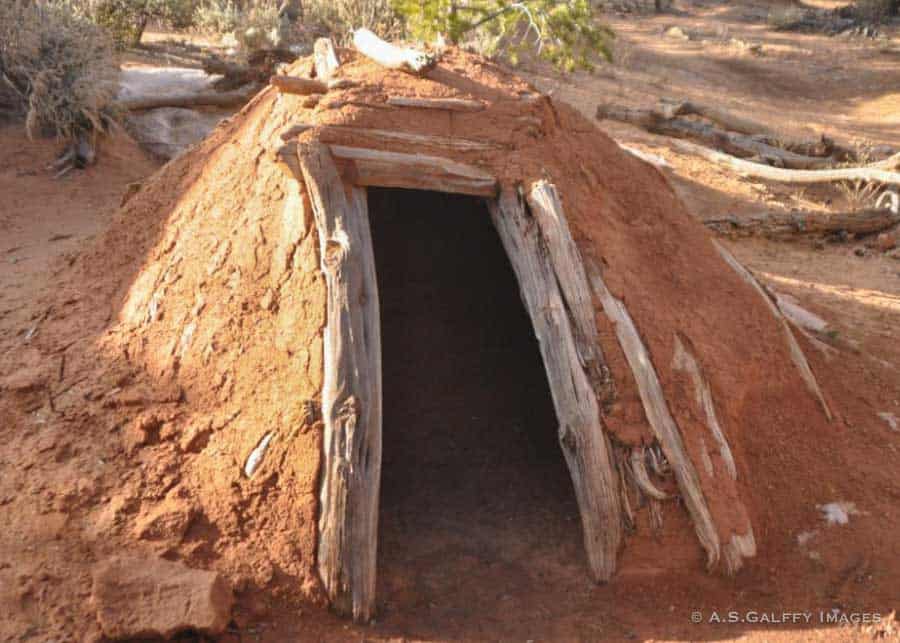
Many of the Indian tribes in Arizona were farmers and gatherers, so they lived in permanent settlements known as Adobe (pueblos). The pueblos were built of stone blocks with mud mortar. Because of the frequent attacks, some tribes built their settlements high up on cliffs. Vestiges of such cliff dwellings are very common in Arizona.
Of all the Native American ruins my favorite one is the Navajo National Monument, which is the oldest cliff dwelling in Arizona. Surrounded by the beautiful Monument Valley, the Navajo Monument is actually located on the Arizona–Utah border.
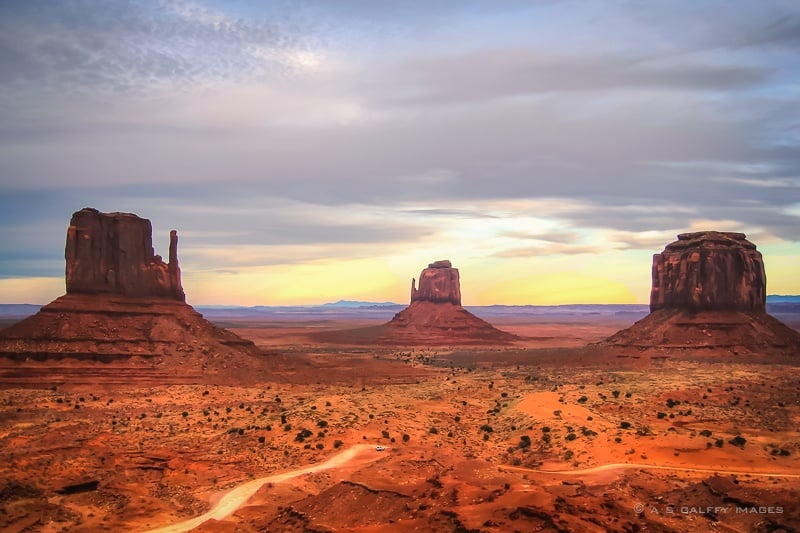
The mythical desert landscape of Monument Valley with its strange rock formations makes you feel like you are on another planet.
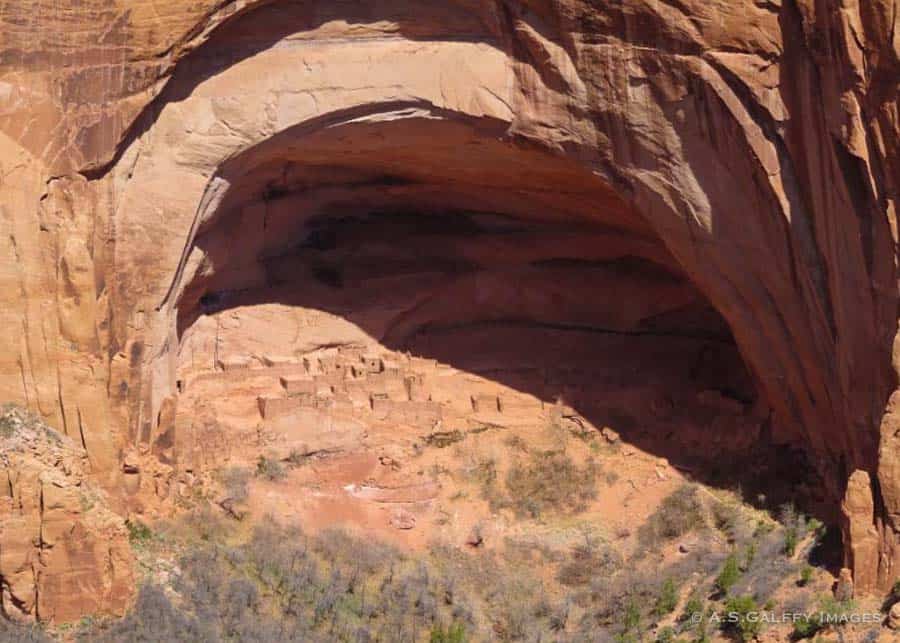
The Navajo Monument sits on an Indian reservation, so it can only be visited with a guide. Truth is that you could easily get lost in this huge space without a guide. Besides, you would definitely need a 4-wheel drive to get around.
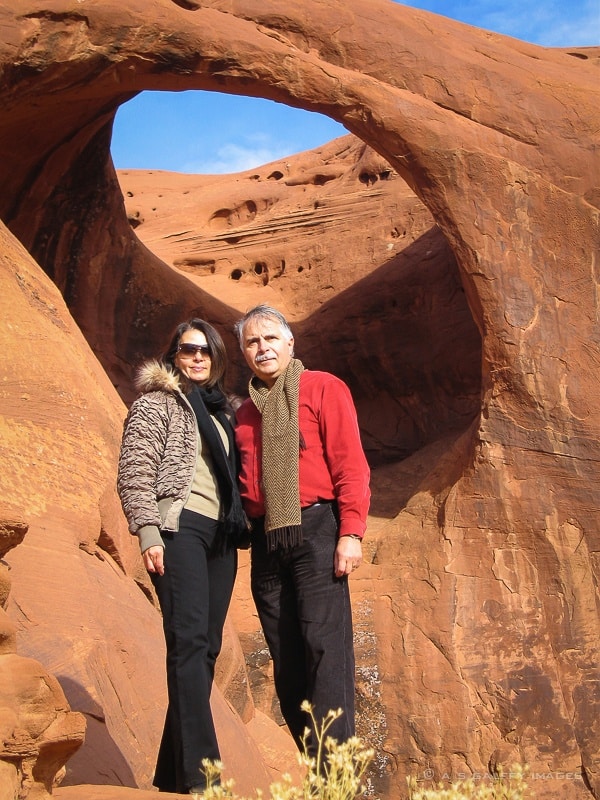
Canyon de Chelly National Park
One of the best preserved Indian ruins in Arizona are the cliff dwellings of the Anasazi tribes, at Canyon de Chelly. The canyon is strikingly beautiful, with sheer sandstone walls that rise up to 1,000 feet. This scenery reminds me a lot about Kings’ Canyon in the Australian Outback.
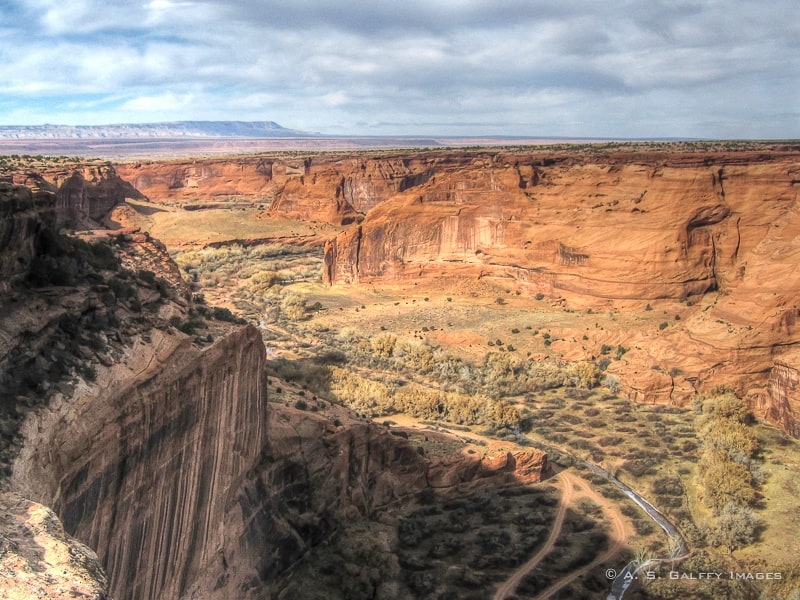
Located within the boundaries of the Navajo Nation, Canyon de Chelly is entirely owned by the Navajo Tribal Trust and the Navajo people still live within the park.
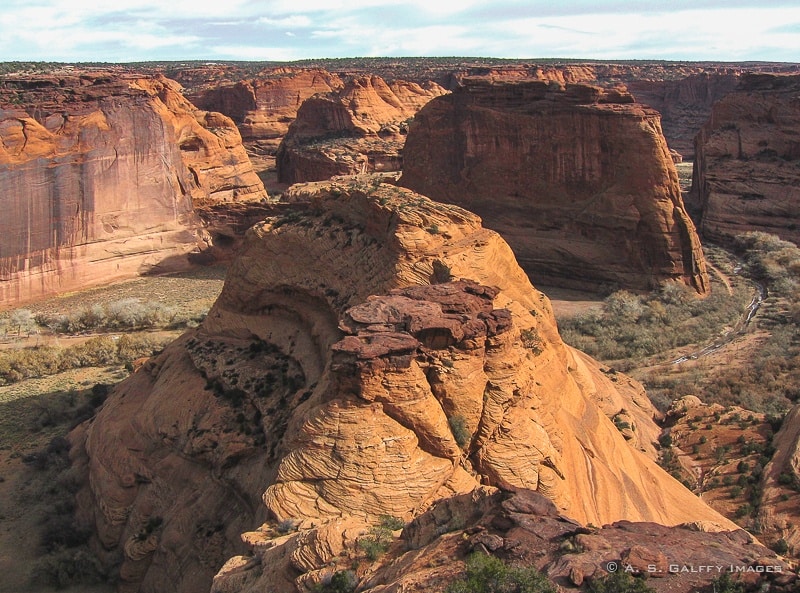
The most spectacular dwelling in the area is the White House ruin. At its peak the village was comprised of about 60 rooms that could house about 100 people.
You may wonder why is this prehistoric village called “the White House.” If you look at the picture below, you’ll see the whitewashed walls of the central room in the upper level of these pueblos. The Navajo mention these ruins in their Night Chant, by calling them Kinii’Na’igai (the White House in Between). Hence the name of the dwelling.
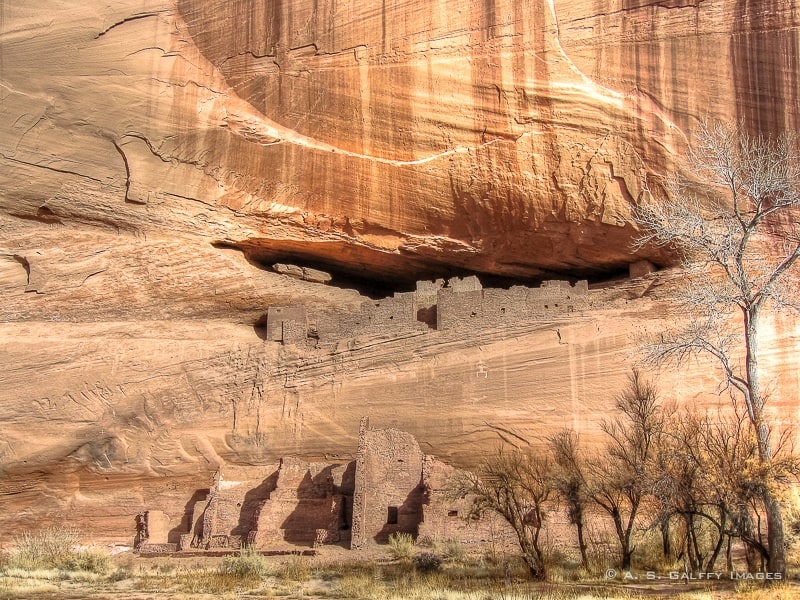
Tips for Visiting the Indian Ruins at Canyon de Chelly, Arizona
There are two rim drives within the monument and both of them offer spectacular views of the Canyon. You can see many of the cliff dwellings from the rim, but can only visit one – the White House ruins – without a Navajo guide. To visit the other ruins you will need to hire a local guide.
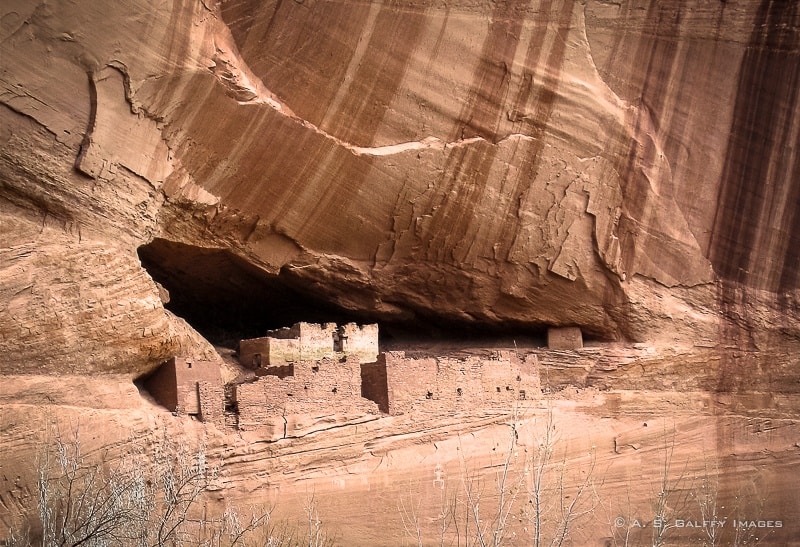
If you really want to experience Canyon de Chelly, you should take the White House trail down to the Canyon floor. The trail is incredible from start to finish: beautiful views, man-carved caves, and tall sheer cliffs. The trail leads to the White House ruins. However, you can’t climb to the Pueblo dwellings as accessing the ruins has been banned since 1951.
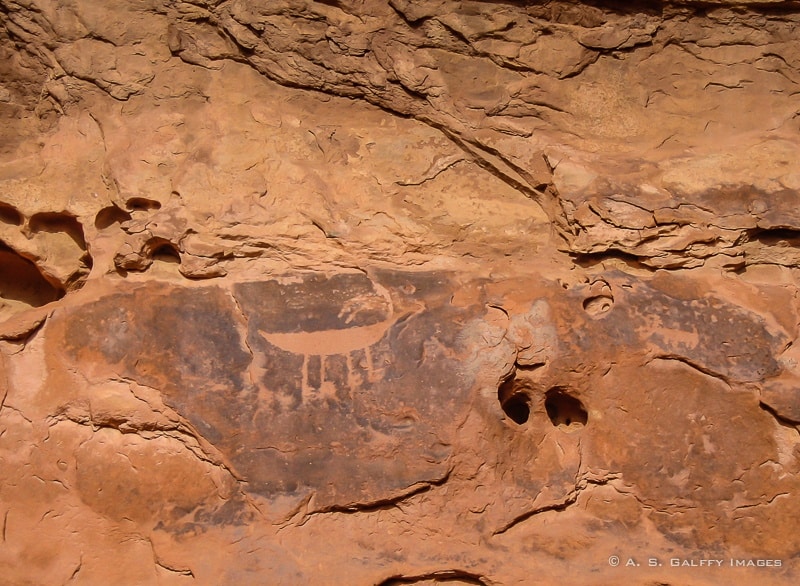
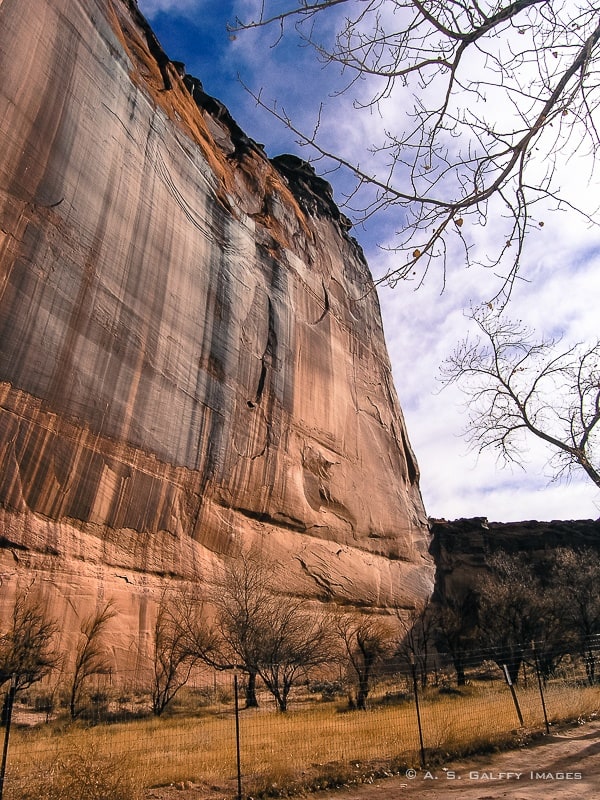
The White House trail is about 2.5 mile long. It took us less than an hour to descend into the Canyon, although the sign says 2 hours. It was late afternoon so we didn’t stay long, but the scenery was spectacular. The road back to the rim was more challenging due to its steepness and the canyon’s high altitude. But the hike was beautiful, with stunning views and many photo opportunities.
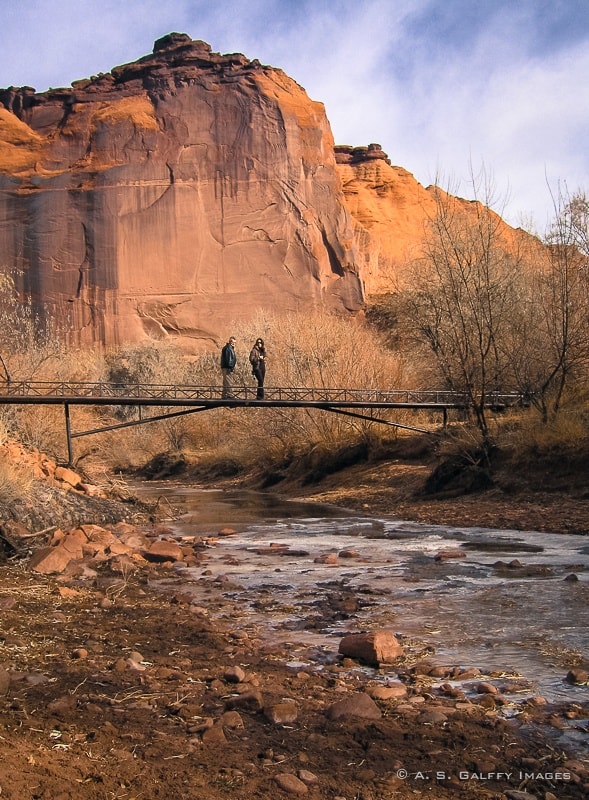
There is no entrance fee for visiting Canyon de Chelly or the White House ruins. The park features a Visitor Center, two rim drives, ten overlooks, and one public trail to visit on your own. Private companies offer tours inside the canyon. The nearest town is Chinle. Here you can find accommodations if you are planning to spend the night in the area.
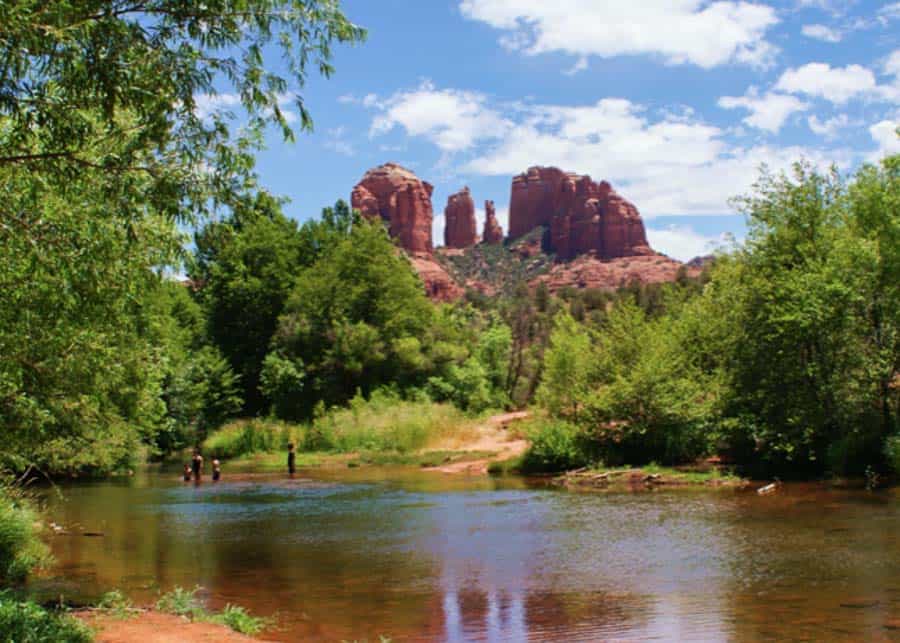
READ NEXT: Hiking the Red Rock Crossing Trail
Indian Ruins Close to Flagstaff, Arizona
Walnut Canyon National Monument
About 10 miles away from Flagstaff lies one of the most amazing Indian ruins – The Walnut Canyon National Monument (also known as the Walnut Canyon Cliff Dwellings.)
This beautiful collection of single-story cliff dwellings sits at an elevation of 6,700 feet (2,100 meters) on the wall of the canyon.
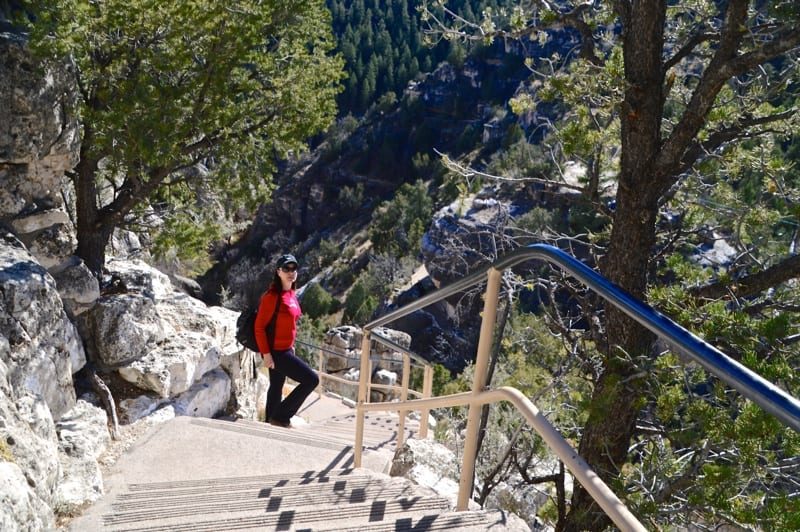
Much like the Grad Canyon, Walnut Canyon was carved by millions of years of water running through steep passes. The canyon floor abunds with pine forests that spread over an area of 3,600 acres. Walnut Creek flows down the canyon floor, creating a good environment agriculture.
The vertical cliffs of the canyon have been home to the Sinagua, a pre-Columbian Indian tribe that lived here between 1100 – 1250 A.D.
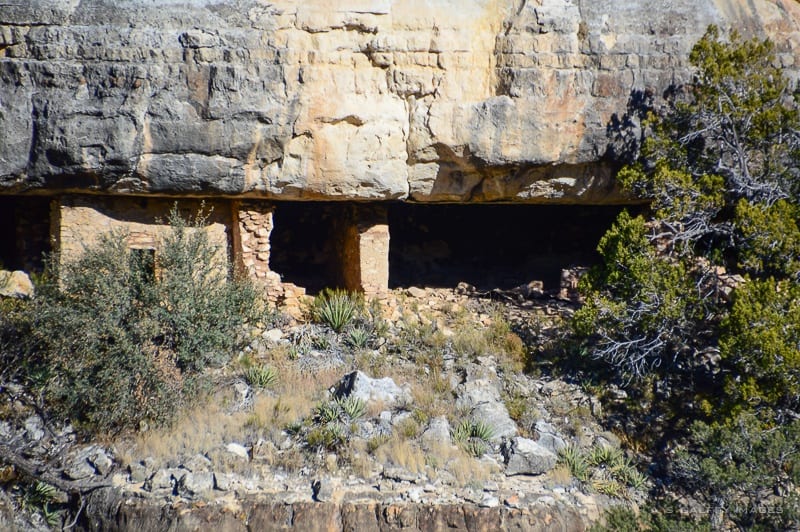
Standing atop the high cliffs at the observation point and gazing down its vertical walls, I was trying to imagine what life must have been like for the ancient Sinagua that once called these cliff dwellings home. An astounding geological formation, the canyon itself is a strange display of shapes.
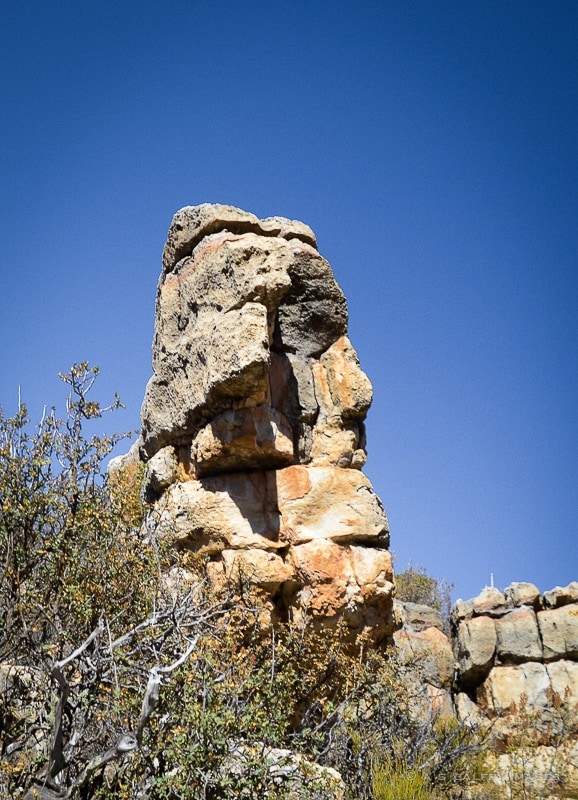
Some of them resemble so much a human body that it’s hard to believe they are the artistic sculptures of water and wind only.
Like many other Indian ruins in Arizona, the cliff dwellings at Walnut Canyon have been abandoned 800 years ago for reasons that remain a mystery to us today.
Tips for Visiting the Walnut Canyon Indian Dwellings
If you don’t want to hike down into the canyon to see the cliff dwellings, you can enjoy a self-guided rim tour along the upper edge. You can enjoy beautiful pine forests and some scenic overlooks of the ruins.
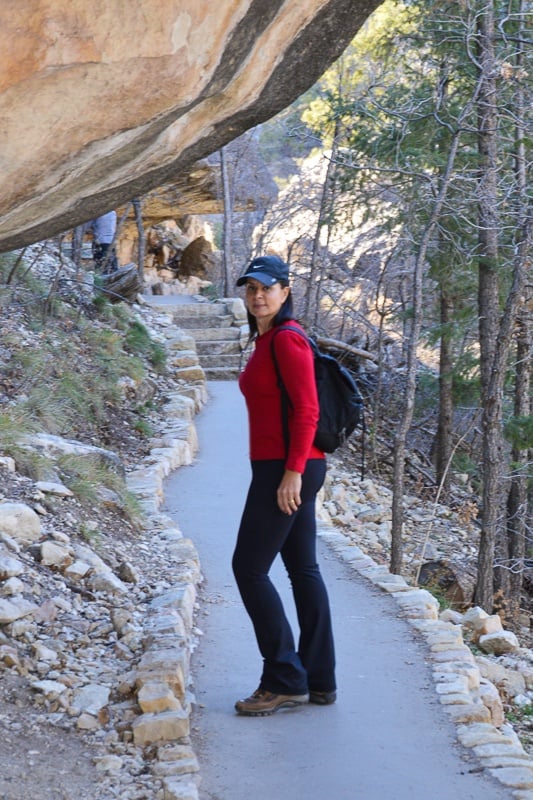
But if you want to see the cliff dwellings up close, you have to opt for the more strenuous walk on the Island Trail. The hike descends more than 185 vertical feet and is only one mile round-trip.
You climb back out of the canyon the same way you came. The paved trail has several sets of stairs which make the ascend and descent possible. Nonetheless, the hike can be difficult due to the high elevation. The advantage of walking the Island Trail is that you’ll get an up close views of 25 cliff dwellings along the route, with even more located just a glance away, across the canyon.
Wupatki National Monument
Another well preserved Indian ruin within close proximity to Flagstaff is Wupatki National Monument. Wupatki is just 30 miles north of Flagstaff and about 59 miles away from Sedona, which is another beautiful spot to explore if you are in the area.
There are more than 800 ruins within the Monument, but only five of them (Wupatki, Wukoki, Lomaki, Citadel and Nalakihu) are closer to the main road. The pueblos have a very distinctive deep red color and are very elaborate. Seeing them you can’t help but wonder: who were these people? Why did they settle in this arid land? How did they live? What caused them to abandon their dwellings which seem so meticulously crafted?
The region was home to the Anasazi and the Sinagua tribes between 1100 AD to 1250 AD, when they mysteriously left the area. Out of the five most important ruins we only visited the Wupatki and Wukoki pueblos.
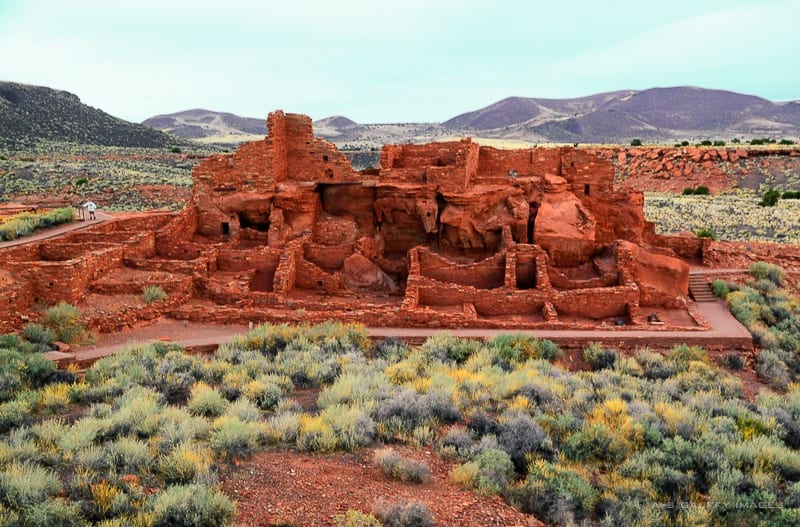
Wupatki is the largest pueblo. The 3-story dwelling was once home to 300 people and had over a hundred rooms. The settlement sits on the edge of a small plateau and has beautiful views of the Painted Desert and the Little Colorado River.
The area is very easy accessible via a trail located directly behind the Visitor Center. The paved trail leads to an outlook that looks down on the ruins and the entire valley of the Little Colorado River.
There is a small entrance fee for visiting Wupatki pueblo, payable at the park’s Visitor Center.
Wukoki Pueblo
Wukoki (“big house” in Hopi) was built only from blocks of Moencopi sandstone. Perched atop a massive isolated boulder that is visible from several miles, the ruin resembles as an old castle rising above the plain. The building blends so well with the surrounding red rock that it seems to grow right out of it.
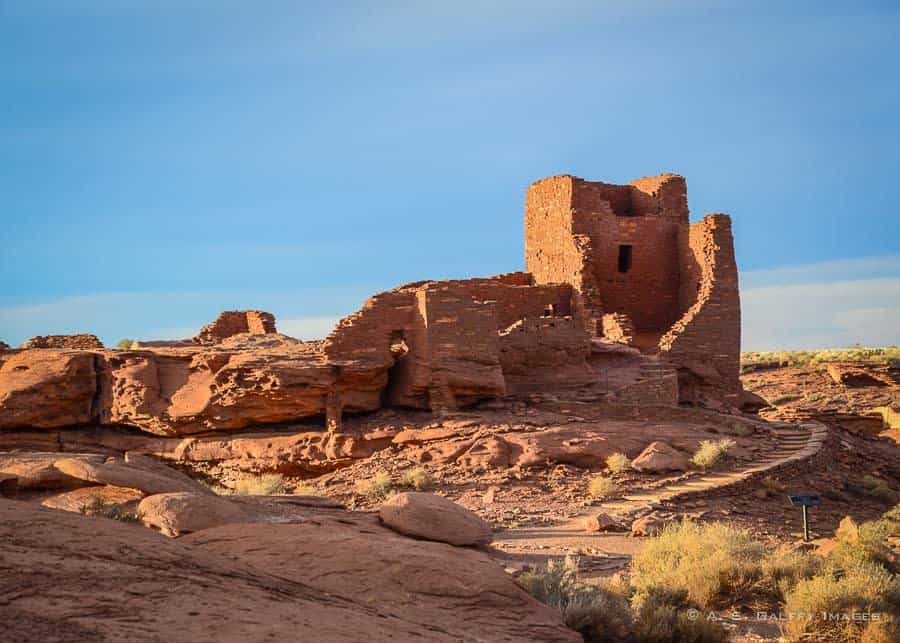
There are no written records of the people who inhabited this place. Archeologists uncovered some pottery, shell beads and stone pendants from Mexico and the remains of more than 40 macaws from Mesoamerica. This discovery led them to believe that Wupatki pueblo was an important center for trade.
You can access the Wukoki Pueblo very easily from the road. There is no entrance fee for visiting the ruins.
Tuzigoot National Monument
The ruins of Tuzigoot are one of several sites south of Flagstaff where you can see the remains of the Sinagua Indian pueblos. Unlike the single cliff dwelling of Montezuma Castle, Tuzigoot is a cluster of buildings on top of a small sandstone ridge. This is very similar to the Wupatki National Monument.
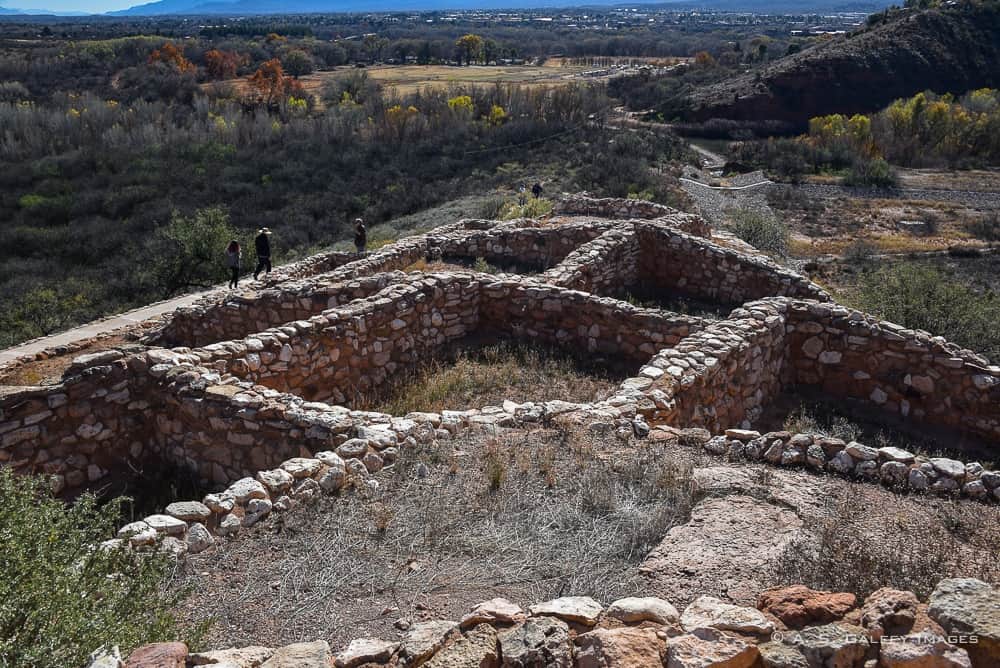
Tuzigoot is small but lovely. At one time this settlement was home to around 250 people.The ruins spans over 42 acres and consist of 110 rooms, including second and third story structures. Most of the rooms are just fragments, with partly-preserved walls a few feet high. The largest dwelling on top of the hill has a reconstructed ceiling and a ladder that leads up to the roof.
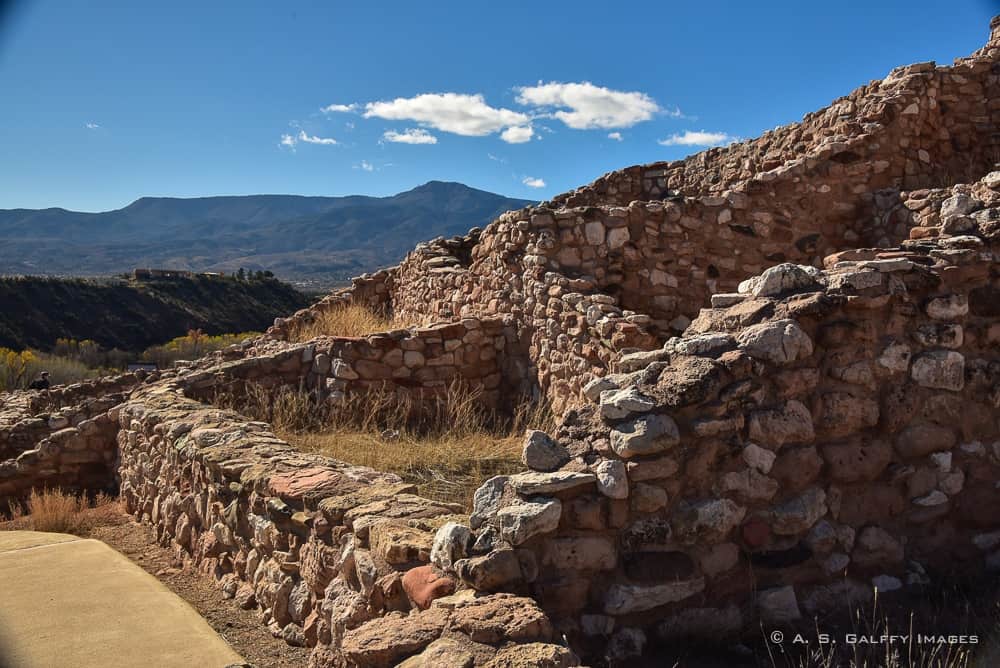
The first buildings date back to around 1000 A.D. The Sinagua were agriculturalists who farmed the land below, but they were also very successful traders. The people left the area around 1400 A.D.
Tips for Visiting the Tuzigoot Ruins
The Tuzigoot dwellings are easy to visit in terms of accessiblitiy. A self-guided 1/3-mile loop trail leads you around and through the ruins. The trail starts at the Visitor Center and offers great views of the Verde River and Tavasci Marsh. At the Visitor Center there is also a small museum and a gift shop.
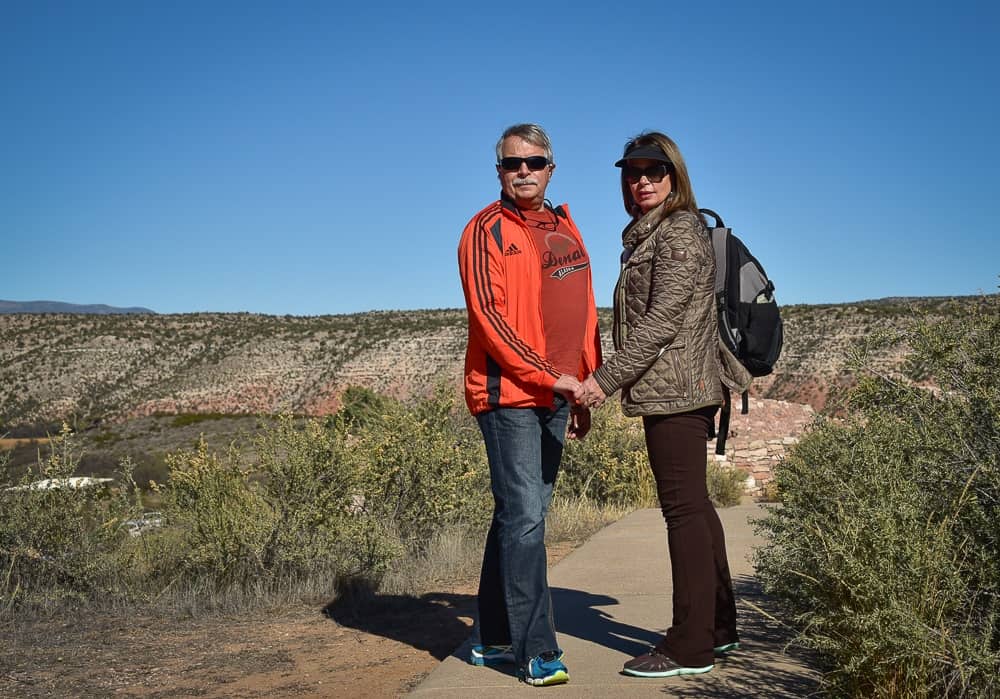
Tuzigoot is an Apache word meaning “crooked water” and that is what actually lies 120 feet below the settlement: the Verde River.
The pueblo ruins were discovered by two graduate students who happened to be invited for dinner at the mansion on the former estate. They noticed an unusual pile of rocks in the area and this is how Tuzigoot resurfaced.
Tuzigoot was excavated in 1933-1934 by archaeologists Louis R. Caywood and Edward H. Spicer. During excavation, 429 sets of human remains were discovered. These were found buried in the hillside with a few personal possessions. Many of these remains were reburied at the site after excavation was completed.
Interesting Facts About the Tuzigoot Dwellings
- The Interior walls were all covered by a red-colored mud, then blackened with some.
- Access to the rooms was almost exclusively through the roofs.
- There were only five side entrances and two of these had been completely sealed up while the pueblos were still inhabited.
- Archeologists speculate that Tuzigoot dwellings were either used for food storage , or they might have been used as a prison.
Indian Ruins Close to Phoenix, Arizona
Montezuma Castle
About 90 miles away from Phoenix, you’ll find one of Arizona’s most spectacular ruins: the Montezuma Castle Monument. The structure is a set of well-preserved cliff dwellings built by the Sinagua Indian tribe around the year 1100.
This 20 room high-rise “apartment building” is nestled into a perfectly vertical limestone cliff, about 90 feet (27 meters) from the ground. The dwellings were accessed through portable ladders, which made it difficult for the enemy tribes to attack it. But perhaps the main reason the Indians choose to built their dwelling so high above the ground was to avoid the the damages caused the annual flooding of Beaver Creek. For unknown reasons, the Sinagua abandoned this place in the 1400s.
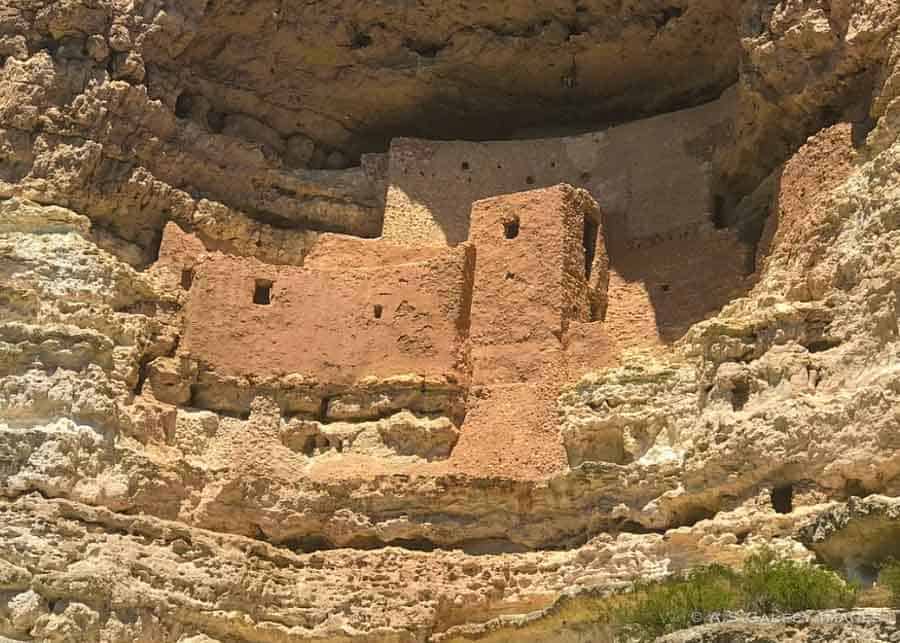
The early settlers who discovered the ruin in 1860s named Montezuma Castle because of a confusion. They erroneously assumed the Sinagua were connected to the Aztec Emperor Montezuma. But in-fact, the Indian tribe of Sinaqua abandoned the dwellings about a hundred years before Montezuma was even born.
Early visitors to the monument were allowed to access to the structure by climbing a series of ladders up the side of the limestone cliffs. But due to extensive damage caused by the public, access of the ruins was discontinued in 1951.
There is an entrance fee for visiting the Montezuma Castle. Visiting the site doesn’t take more than 30 minutes.
Casa Grande Ruins National Monument
54 miles away from Phoenix lies another well preserved monument: the Casa Grande Ruins. Built by the ancient Hohokam people, this is one of the largest prehistoric structures ever built in North America.
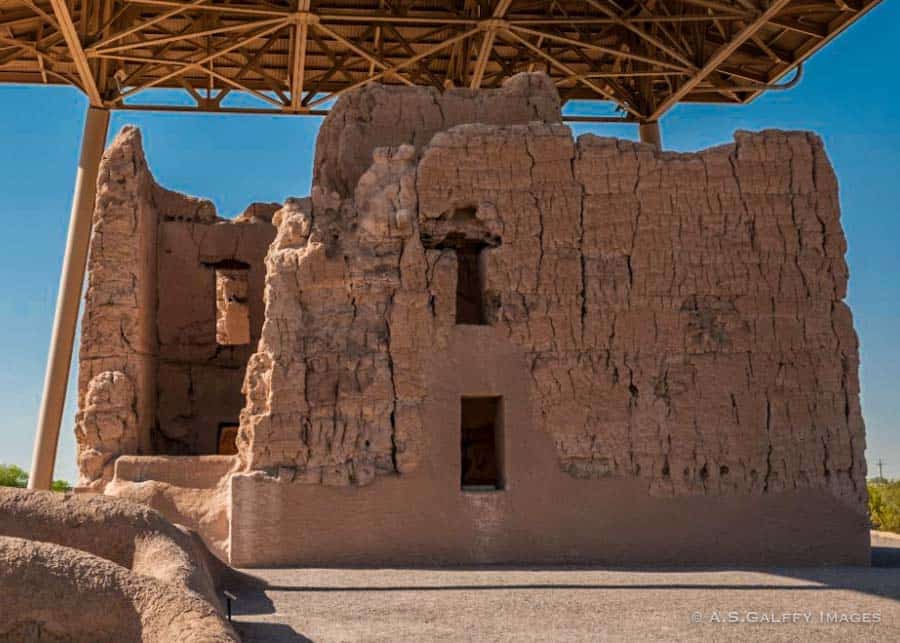
The monument is very impressive, but if you want to make sense of what you see you should watch the little movie at the visitor center before starting your visit. It’s interesting to see how this group of people could build such a water system in a dry place like this.
There is a small museum at the Visitor Center which is incredibly informative with real artifacts and reconstructed dwellings. You learn a lot about ancient Hohokam history and culture. Admission is free.
Pueblo Grande Museum & Cultural Park
Located in downtown Phoenix, near the Sky Harbor International Airport, the Pueblo Grande is a very educational museum that preserves the remnants of an ancient Hohokam Indian Village.
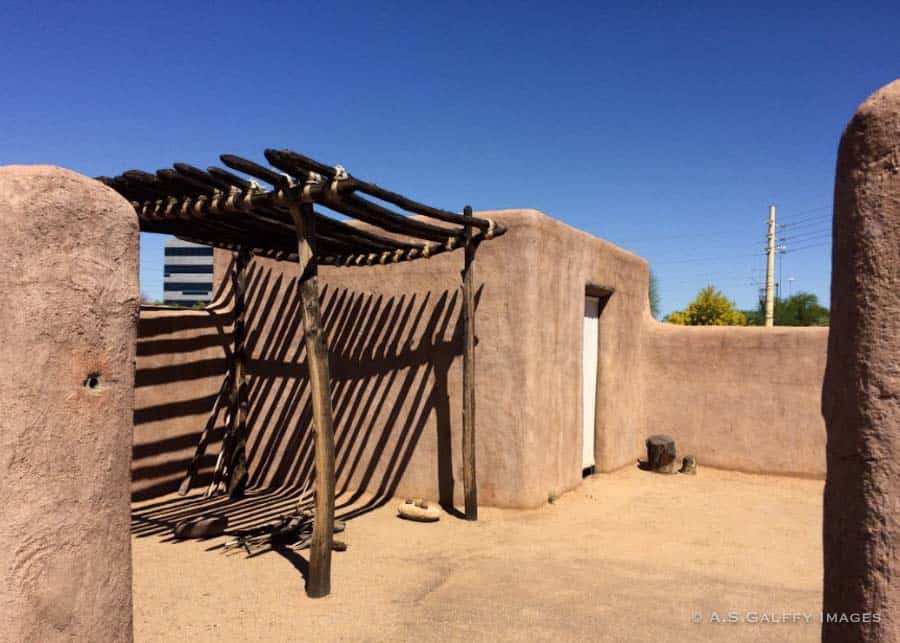
There is an interpretive trail on which you will discover some of the last Hohokam irrigation canals that remained intact. The exhibits are very informative and the entire site is quite easy to explore. However, it’s best to visit on a cool day since most of the points of interest are located outside.
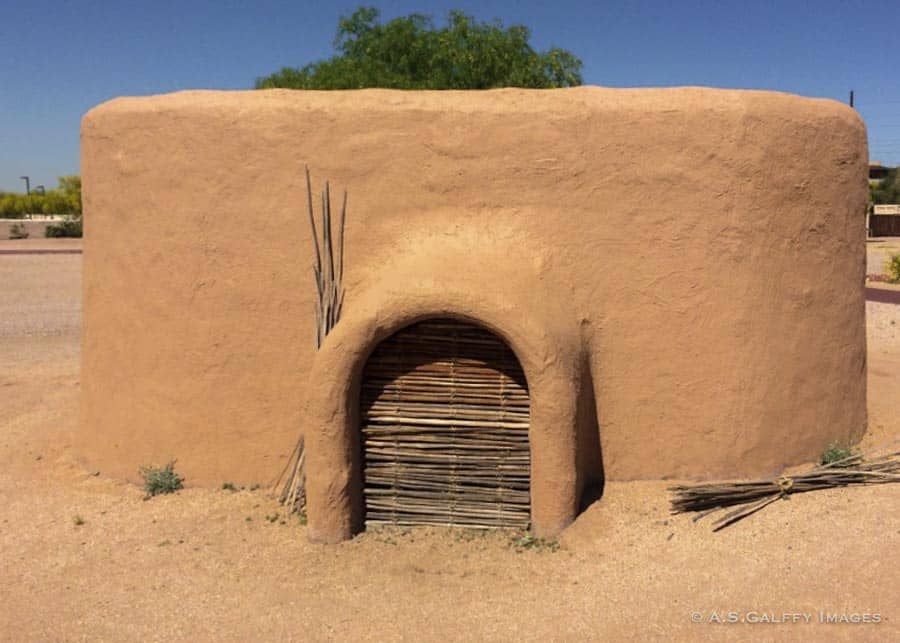
Tonto National Monument
I always like to visit Native American vestiges when I am in Arizona, and Tonto National Monument is one of my favorite ones because it’s not very heavily visited, so you can enjoy it without the crowds. This area has some very well-preserved cliff dwellings in shallow caves that were occupied during the 13th, 14th, and early 15th centuries until about AD 1450.
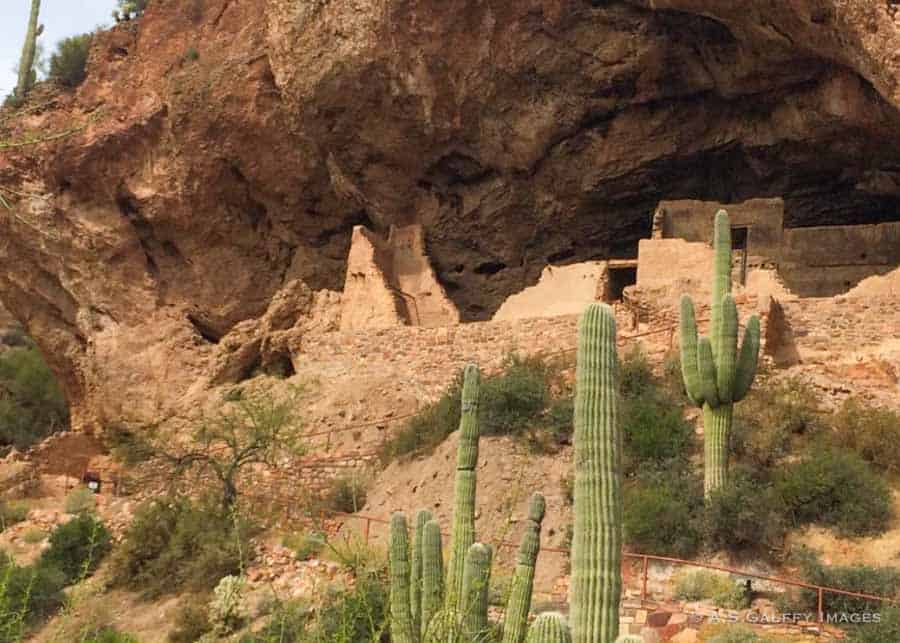
Tonto National Monument is situated within rugged terrain in the northeastern part of the Sonoran Desert. The people who lived in this region were farmers, hunters and gatherers. They were also very fine craftsmen, producing some of the most exquisite pottery and intricately woven textiles that you can find in the Southwest. You can see many of these objects at the Visitor Center museum.
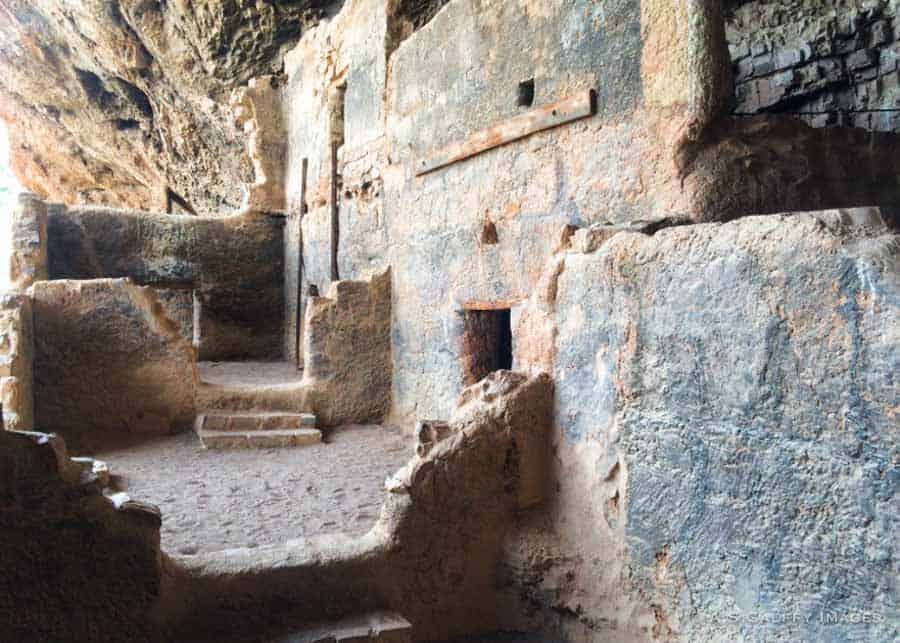
You can visit the monument on a self guided tour. To access the Lower and the Upper cliff-dwelling trail you have to climb to pretty high elevation (about 3,150 feet), but the path is only half-mile long. This is a small park, but it’s really beautiful, amid lovely desert scenery. There is an entrance fee for visiting the park.
Interested in reading more about Arizona? You may like these posts:
Jerome, America’s Largest Ghost Town
Hiking the Cathedral Rock Trail in Sedona
Hiking the Burins Mesa Trail in Sedona, Arizona
5 Sedona Wineries that Offer an Unforgettable Experience
Did you enjoy this post? Pin it for later:
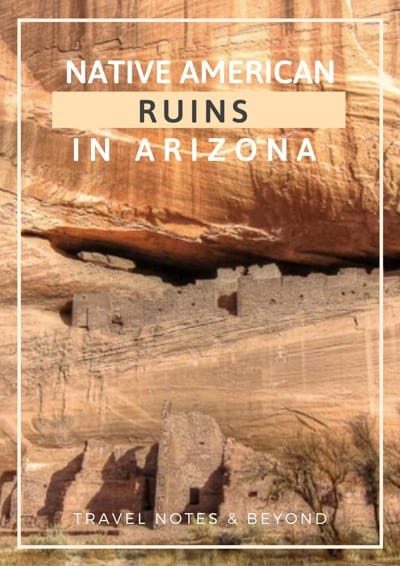

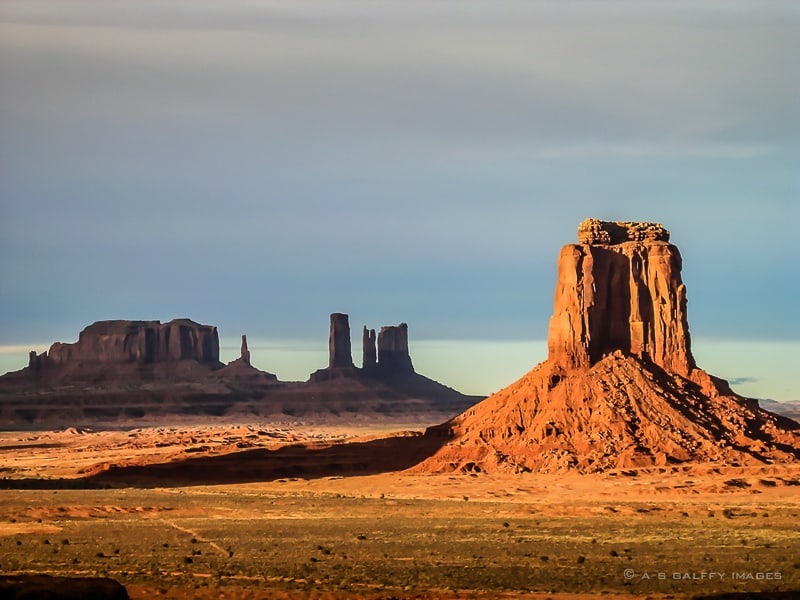
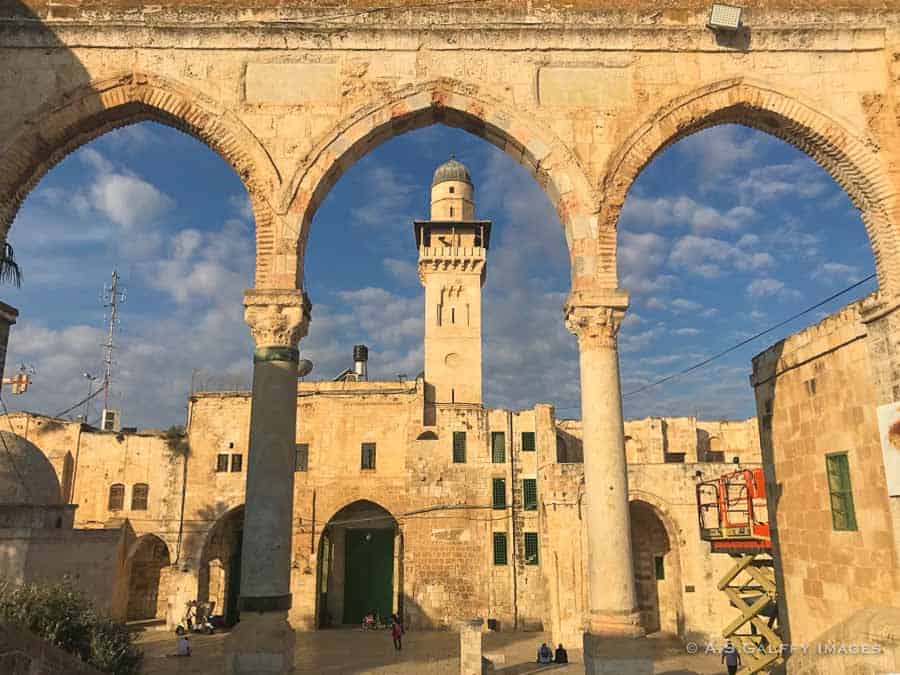 The Best Two-Week Itinerary for Visiting Israel Independently
The Best Two-Week Itinerary for Visiting Israel Independently



Cindy
Nice round-up of sites — few people seem to know about Walnut Canyon, even through it’s easy to get to. (We ended up there without realizing it was a Native site — we just saw the sign and decided to check it out!) I can’t believe I haven’t gotten to Canyon de Chelly – I can see I need to make that a higher priority and plan a trip to Arizona sometime other than winter! The one you are missing is Palatki right outside Sedona. They have a smaller cliff dwelling site (but you can walk up to it on a guided tour) as well as a wonderful pictograph site. Such interesting links to the past.
Anda Galffy
Thanks for letting me know about Palatki, Cindy. I didn’t know about this Indian dwelling, but I’ll surely check it out next time we go to Sedona.
Richard
A park employee at Palatki confirmed to me and my friend that there is much more to the dwellings there that are not open to the public. From where we were camping, using a powerful set of binoculars, you can see what look like dwellings high in the cliff face, and even manmade walls. It almost looks as if the various cave openings could be connected by tunnels.
I saw similar dwellings like this in Kofa Queen Canyon, high above the canyon floor. Granted, a lot of mining took place there, but this looks much more primitive than a mining cave, with a brick wall built to cover most of the cave entrance. Miners wouldn’t have had a wall in their way as they were lowering whatever material they were mining.
Debra Schroeder
I’ve been to Montezuma Castle on the way to Sedona but hadn’t realized how many ruins there were in Arizona, especially one so close to the airport. I’m here in Phoenix now. Bummed I didn’t read your post before my trip. Next time I’m out here I’ll have to make plans to include a visit to Canyon de Chelly among others.
sherianne
I love checking out ruins when I travel. Mesa Verde and Taos are my favorites but I haven’t heard of Navajo National Monument. The images of Wupatki National Monument red rocks are gorgeous. I have a friend in Flagstaff, I think a road trip is due!
Anda Galffy
Agree. A road trip through Arizona is always a good idea.
Pashmina Binwani
These pictures of the Indian ruins in Arizona are wonderfully taken. I never heard about Wupatki and how this 3-story dwelling was once home to 300 people! It’s fascinating to read about this and understand the deep history behind these ruins which you have captured so vividly with your descriptions. I enjoyed reading this and hope to visit Arizona one day!
Paula
Wow, Arizona is so amazing! It was interesting to read this since we just visited some of the areas last spring. We spend a day at Wupatki and surrounding areas, and got to know some Navajo land. I would love to see especially Canyon de Shelly. Thanks for all the great tips.
Yukti Agrawal
I never knew about Indian ruins in Arizona as I always thought it as a desert. Good to see some ruins of Indian tribes in Arizona who were farmers and gatherers, and their permanent settlements – Adobe (pueblos). It must be interesting to visit this place and spot some ruins of the pueblos which were built of stone blocks with mud mortar. Remains of such cliff dwellings must be very photogenic in this place. Thanks for sharing some great history behind this place.
Anda Galffy
Arizona is truly beautiful, Yukti. It’s not only the Indian dwellings that are an attraction there, there are spectacular hikes in those canyons.
Lisa
It’s so fascinating reading about these Indian ruins, mainly because they were the original settlers in the US. I also never knew that Arizona had these ruins, so I enjoyed reading this immensely. I’m in awe of Monument Valley and Canyon de Chelly, how incredible are they! I’d definitely book a guide to fully appreciate these ruins.
Anda Galffy
Maybe it’s time for a trip to Arizona, Lisa. I’m sure you’d enjoy it a lot.
Ami Bhat
Now those are quite a variety in the ruins. I did not realize that there was so much of a difference. Among all the places to described, was quite intrigued by Wupatki National Monument. 800 ruins just in one place sounds quite a deal. Thanks for sharing this article. Quite enjoyed reading it.
Rhonda Albom
I didn’t realize how many Indian ruins there were in the Southwest. Years ago, I visited one of these ruins and remembered having to climb some ladders to get access. The finding of macaw remnants in the Wukoki Pueblo and attributing them to trade is quite interesting.
Anda Galffy
There are way many more ruins than I mentioned here, but here are the best preserved ones.
Danik
After reading this there is actually more Indian Ruins in this part of the States then I thought there was. I didn’t even know about the pit houses existence until today. However out of all these sights, I do know of Monument Valley and its a place which is high up on my list when I eventually get to Arizona. One day! And I have to admit, by the looks of some ruins, the indians built homes underneath cliff faces to shade from the sun?
Anda Galffy
Not sure about that, Danik. They probably built underneath cliffs to protect themselves against attackers.
Emese
Great post, Anda. As you can guess, we love visiting all of these sites. Though I have to say, my all-time favorite is Canyon de Chelly. Love your photos; as always, they are gorgeous.
Anda Galffy
Thank you, Emese. Good to hear from you. Hope you’ll have a wonderful New Year.